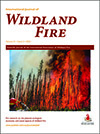International Journal of Wildland Fire
Volume 31
Number 3 2022
Our study found that weather conditions (Modified Nesterov Index, temperature, relative humidity) were the most important determinants of fire occurrence in the tropical forests of northern Vietnam, with important contributions also from anthropogenic and topographic factors. Fire was more frequent in natural forest but burn area was larger in plantations.
In this study, the relationship was quantified between the self-calibrated Palmer Drought Severity Index and wildfire burn area in California during the time period 1984–2018. The results indicate that the drought was one of the main drivers for wildfire burn area in California. The results can be used to aid damage control of future wildfires in California.
Fire plume heats tree crowns and causes the mortality of live vegetation. An analytical model that explores the basic physical processes of linear fire combustion, heat transfer and thermal response of needles and leaves is developed in this work to link the fire intensity and flame height to the crown scorch height.
Two models were developed to predict crown fuel consumption in Canadian boreal forest fires. Fire rate of spread and fuel load of live tree overstorey foliage and dead tree branchwood were the main factors affecting crown fuel consumption. These models can be operationally applied using common forestry or carbon datasets.
We present an advanced approach of flammability index estimation that allows a more detailed evaluation of wildland fuel flammability by integrating all four flammability components. It can be used to inform the selection of less flammable plant species to manage wildland fuel hazard more effectively.
Determinants of remotely sensed fire severity were investigated for a large recent wildfire. Effects of environmental predictors depended on the choice of fire severity index and fire behaviour insights were confounded by pre-fire vegetation height. Robust insights require consideration of the meaning and limitations of optical remote sensing indices.
QES-Fire is a fast-response wildfire progression model that dynamically couples the fire front to the local winds. Using simplified physics models, the heat release from the fire is used to generate fire-induced wind. These winds drive the fire front’s rate of spread. The model compares well with experimental burns.





